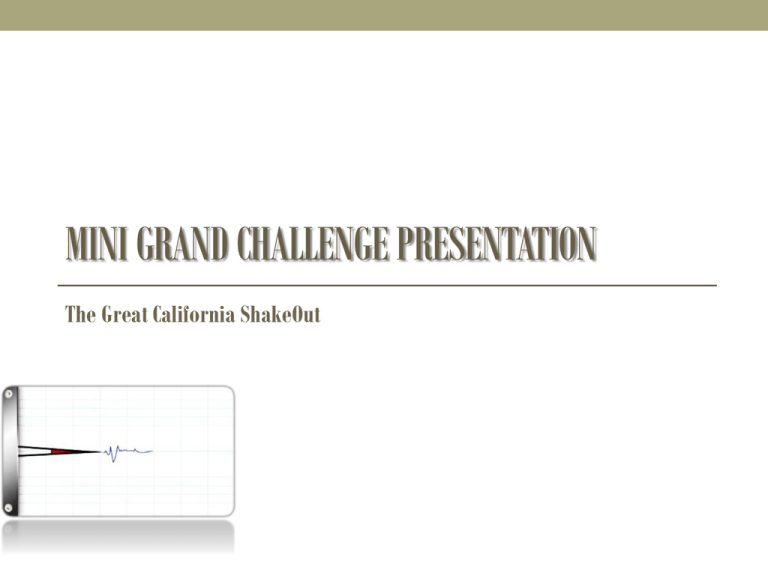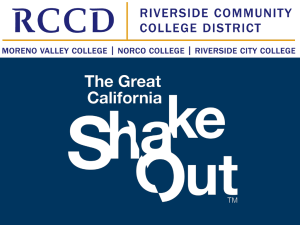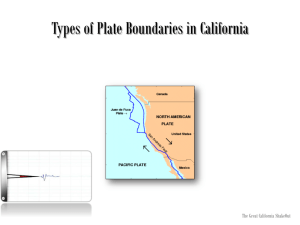Mini Grand Challenge Presentation
advertisement

MINI GRAND CHALLENGE PRESENTATION The Great California ShakeOut The Great California ShakeOut Outline (i) (ii) (iii) (iv) (v) (vi) Plate boundaries in California California, “Earthquake Country” Faults of the San Francisco Earthquake Locating faults in California Focal mechanisms and Seismic Data Earthquakes’ dependency on faults The Great California ShakeOut Types of Plate Boundaries in California The Great California ShakeOut Types of Plate Boundaries Divergent Boundaries: Two plates pull apart Convergent Boundaries: Two plates push together Transform Boundaries: Two plates slide horizontally against one another Plate boundary zones: Sometimes boundaries are not well defined, especially if they involve more than two plates. The Great California ShakeOut Plate Boundaries in California Transform boundary between the Pacific and North American plates along the San Andreas Fault Convergent boundary at the Cascadia Subduction Zone Convergent boundary at the bend in the San Andreas Fault Divergent boundary at the Brawley Seismic Zone The Great California ShakeOut SCEC-VDO Visualization The Great California ShakeOut References Kious, W. J., and Robert I. Tilling. "Understanding Plate Motions." This Dynamic Earth, USGS. United States Geological Survey, Feb. 1996. Web. 18 June 2013. <http://pubs.usgs.gov/gip/dynamic/understanding.html>. "The Salton Seismic Imaging Project." Earthquake Hazards Program. United States Geological Survey, 11 Dec. 2012. Web. 18 June 2013. <http://earthquake.usgs.gov/research/structure/salton/>. "Plate Boundaries." Department of Earth Sciences. Freie Universität Berlin, 31 Mar. 2008. Web. 18 June 2013. <http://www.geo.fu-berlin.de/fb/elearning/geolearning/en/mountain_building/plate_tectonics/index.html>. The Great California ShakeOut The State of California: “Earthquake Country” The Great California ShakeOut SCEC-VDO Visualization The Great California ShakeOut References “Plate Tectonics.” Pacific Northwest Seismic Network. Web. 18 June 2013. <http://www.geo.fuberlin.de/fb/e-learning/geolearning/en/mountain_building/plate_tectonics/index.html>. The Great California ShakeOut Finding Fault in California The Great California ShakeOut Normal Faults Basin and Range Province The Great California ShakeOut Reverse and Thrust Faults Fault Scarps The Great California ShakeOut Strike-Slip Faults Offset stream channels 1906 San Francisco Earthquake Sag Ponds (Elizabeth Lake) The Great California ShakeOut SCEC-VDO Visualization The Great California ShakeOut References Bolt, Bruce A. Earthquakes. 5th ed. New York: W.H. Freeman, 2003. Print. Hough, Susan Elizabeth. Finding Fault in California: An Earthquake Tourist's Guide. Missoula, MT: Mountain Pub., 2004. Print. Michaelsen, Joel. "Basin and Range (Transierra) Region Physical Geography." Basin and Range Region. U.C. Santa Barbara, n.d. Web. "The San Andreas Fault." The San Andreas Fault - V. Surface Features. Department of the Interior, U.S. Geological Survey 11 Jan. 2013. Web. The Great California ShakeOut Focal Mechanisms and Seismic Data Focal mechanisms are visualization models that show: • direction of slip in an earthquake • attitude of movement along the fault • orientation of stress Fault Plane Auxiliary Plane Strike Slip Right Lateral The Great California ShakeOut Seismologists analyze the first P-waves from the Earth that either compress or dilate the ground at multiple stations. First Motion Ground Movement Compression UP Dilation DOWN Null No apparent motion The Great California ShakeOut At each seismograph station: First motion P-waves are analyzed to show orientation of stress and slip along the fault. A B A Reverse Fault A B Lower Hemisphere Projection Areas of compression and dilation are plotted on stereonet projection and the best fit line separating the zones of stress is drawn, creating the “beach ball” diagram. Illustrations by Ani Pytlewski A The Great California ShakeOut How do geologists determine the Fault Plane ? • Aftershocks • Seismic history • Field evidence for strike, dip, and rake of the fault (correlate to focal mechanism) • Ray Path geometry Additional field data is needed to differentiate between the auxiliary and fault plane. The Great California ShakeOut SCEC-VDO Visualization The Great California ShakeOut References Cronin, V., 2004, A draft primer on focal mechanism solutions for geologists, Baylor University, p. 1-14 Johnson, Jenda. “Focal mechanism.” Incorporated Research Institutions for Seismology. 2013. Web. 18 June 2013. <http://www.iris.edu/hq/programs/education_and_outreach/ animations/25 >. Lillie, R. J., 1998, Earthquake seismology, Whole earth geophysics: An introductory textbook for geologists & geophysicists, p. 185-220 Rowan, Chris. “5 focal mechanisms.” 29 December 2009. Web. 18 June 2013. <http://allgeo.org/highlyallochthonous/2009/12/5-focal-mechanisms/>. The Great California ShakeOut Do Earthquakes Always Occur on Faults? The Great California ShakeOut NO • Caused by sudden release of energy • Tectonic earthquakes are focused on a fault • Induced seismicity • Volcanism The Great California ShakeOut Volcanism • Earthquakes caused by the movement of magma through the earth’s crust • Magma releases energy that causes shaking Mount St. Helens Erupting The Great California ShakeOut Induced Seismicity • Extraction of fossil fuels or ground water • Reservoirs • Mining • Geothermal energy The Great California ShakeOut SCEC-VDO Visualization The Great California ShakeOut References Chong, Kian H. "Fault Plane." USGS. N.p., n.d. Web. "Earthquake." Wikipedia. Wikimedia Foundation, 06 June 2013. Web. 13 June 2013. "Induced Seismicity." Wikipedia. Wikimedia Foundation, 06 Nov. 2013. Web. 19 June 2013. "Mexico City, September 19, 1985." ANIMAL. N.p., n.d. Web. 20 June 2013.






